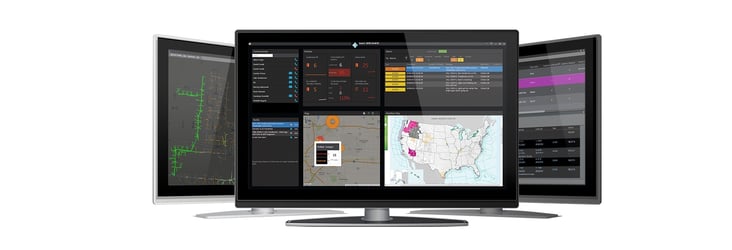This post is one in a series featuring the complete slate of advanced energy technologies outlined in the report This Is Advanced Energy.

Image courtesy of AEE member GE.
Building on new tools such as distribution automation and advanced metering infrastructure, utilities have begun to harness a number of advances in software and IT to improve the management and operation of the distribution system. These include Distribution Management Systems (DMS), which synchronize automated reclosers, capacitors, and other systems that manage the flow and quality of power on the distribution system; Outage Management Systems (OMS), which pinpoint faults and dispatch repair crews quickly; and Geographic Information Systems (GIS), which plot equipment, lines, and faults. These systems often run on different platforms from different vendors, requiring operators to use multiple interfaces and manually compile information.
Advanced Distribution Management Systems (ADMS) combine all of these functions on a single, integrated software platform that also makes use of other systems such as AMI. ADMS provides the “brain” that ensures new IT-enabled system controls are harnessed in a way that optimizes the management and operation of the entire distribution system. For instance, in the event of a power outage, ADMS can detect the location of the fault, determine which customers are without power, reroute power to bring as many customers back online as quickly as possible, institute measures such as voltage reduction to protect reliability, and dispatch repair crews to bring remaining customers back online. Without an ADMS and supporting systems, this process is lengthy and cumbersome.
ADMS is a relatively new platform. Early deployments include PPL Electric Utilities in Pennsylvania; Austin Energy in Texas; CenterPoint in Texas; Entergy in Louisiana, Arkansas, Mississippi, and Texas; and Oklahoma Gas and Electric in Arkansas and Oklahoma. ADMS helped shave time off of restoration efforts in the wake of Hurricane Irene, one of the largest outage events in PPL’s history. At CenterPoint Energy, ADMS has saved customers from over 100 million minutes of outages since deployment began in 2011. CenterPoint saw its reliability metrics improve by 28% in a single year, while more ef cient operations and maintenance lowered costs. Navigant Research estimates that the global market for ADMS will grow from an annual $681 million in 2015 to $3.3 billion in 2024.
By optimizing grid operations, ADMS can increase the amount of efficiency obtained through Volt-VAR Optimization, directly dispatch demand response resources, avoid or defer costly infrastructure upgrades, and help utilities plan for and manage customer-controlled resources on the grid, such as microgrids and distributed generation. Utilities that have deployed ADMS have found that they are better able to forecast load and generation on the grid because they are now able to monitor and plan for DG as actual generation rather than treat it as a load reduction, as is the case now in most utility systems.
